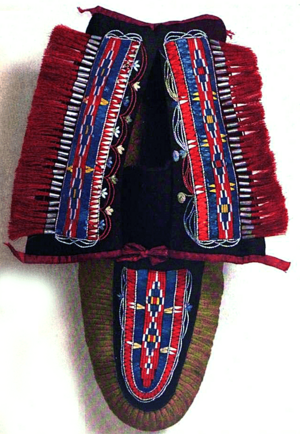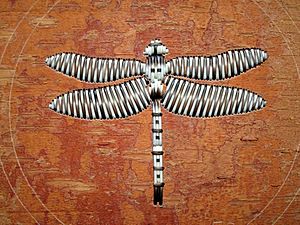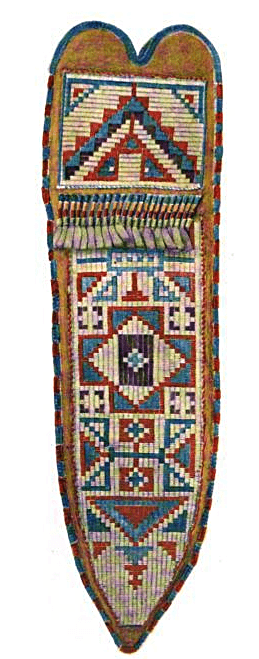Quillwork facts for kids

Quillwork is a special art form where people decorate things using the sharp quills (spines) from porcupines. Sometimes, quills from bird feathers were also used. This beautiful art is a traditional practice of Native Americans.
Contents
History of Quillwork

Quillwork using porcupine quills is an art form found only in North America. Before glass beads arrived, quillwork was a very important way to decorate things for Native American groups living where porcupines are found. This included people in the Subarctic, Northeastern Woodlands, and Northern Plains. People used quills in their designs all the way from Maine to Alaska. Tools for quillwork have been found in Alberta, Canada, that are over 1,400 years old!
Cheyenne Quillwork Traditions
The Cheyenne people have a special story about how quillwork began in their tribe. It's told that a man married a woman who was secretly a buffalo. Their son was also a buffalo. The man visited his wife and son in their buffalo home. While he was there, he learned the art of quilling. He then shared this amazing skill with the women of his tribe.
Joining the Cheyenne Quilling Society was a great honor for Cheyenne women. When they first joined, women would practice by quilling moccasins. Then they would work on cradleboards, which are special carriers for babies. After that, they would decorate rosettes for men's shirts and tipis. Finally, they would create designs on hide robes and backrests.
What Was Decorated with Quills?
Porcupine quills often decorated rawhide (untreated animal skin) and tanned hides (treated animal skin). In the 1800s, quilled birch bark boxes became popular items to trade with European-Americans. These were made by tribes in the Eastern and Great Lakes regions.
Quillwork was used to make and decorate many different items used every day by Native American men and women. These included clothes like coats and moccasins, accessories like bags and belts, and even parts of furniture like cradle covers.
How Quillwork is Made
The quills used for decorating are usually two to three inches long. They can be dyed before they are used. Naturally, quills are pale yellow to white with black tips. The black tips are usually snipped off before use. Quills easily soak up dye. Originally, dyes came from local plants and offered many colors, with black, yellow, and red being the most common. By the 1800s, new dyes called aniline dyes became available through trade, making it easier to color the quills.
Tools and Techniques
The quills can be flattened using special bone tools or by running them through one's teeth. Sharp tools called awls were used to poke holes in hides. Sinew (strong fibers from animal tendons) was used to tie the quills to the hides. Later, European thread replaced sinew.
There are four main ways to do quillwork:
- Appliqué: Quills are sewn onto a hide in a way that hides the stitches.
- Embroidery: Similar to appliqué, but often involves more detailed stitching patterns.
- Wrapping: A single quill can be wrapped around itself, or two quills can be twisted together.
- Loom weaving: Quills are woven together on a special frame called a loom.
Quillwork Styles
Quills can be sewn on one by one to create curved patterns. This style is seen on Odawa pouches from the 1700s. This technique was great for making floral (flower) designs. These flower designs became very popular among northeastern tribes thanks to Ursuline nuns. Huron women were especially good at floral quillwork in the 1700s and 1800s.
Plains quillwork is known for its bands of rectangles that create geometric patterns. These patterns are also found in Plains paintings. Rosettes (round, flower-like designs) made of circles of quillwork often decorated men's shirts in the past. Parallel strips of quillwork were also common on shirt sleeves. These very abstract designs had many layers of special meanings.
The Red River Ojibwe people from Manitoba created neat, geometric patterns by weaving quills on a loom in the 1800s.
Quillwork Today

Quillwork has never stopped being a living art form in the Northern Plains. Some communities that had lost their quillwork traditions have been able to bring the art form back. For example, by the late 1990s, no women were quilling in the Dene community of Wha Ti, Northwest Territories. The Dene Cultural Institute held two workshops there in 1999 and 2000, which successfully brought quillwork back to Wha Ti.
The art form is very much alive today. Many talented artists continue to create beautiful quillwork. Some award-winning quillworkers include Juanita Growing Thunder Fogarty (Sioux-Assiniboine), Dorothy Brave Eagle (Oglala Lakota) from Denver, Colorado, Kanatiiosh (Akwesasne Mohawk) from St. Regis Mohawk Reservation, Sarah Hardisty (Dene) from Jean Marie River, Northwest Territories, Leonda Fast Buffalo Horse (Blackfeet) from Browning, Montana, and Deborah Magee Sherer (Blackfeet) from Cut Bank, Montana.
Northern Lakes College in Alberta, Canada even teaches a college-level course in quillwork art.


